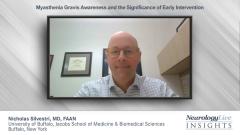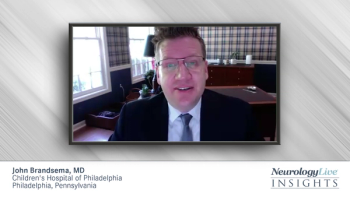
Myasthenia Gravis Awareness and the Significance of Early Intervention
Nicholas Silvestri, MD, FAAN, discusses the level of awareness of myasthenia gravis (MG) and generalized MG among primary care physicians and the public, and the type of harm patients might sustain if they do not receive timely treatment.
Nicholas Silvestri, MD, FAAN: Myasthenia gravis is a fairly rare disease. Many doctors have heard of it at some point in the course of their training, but they may not have seen it because of the rarity of the disease. Most individuals in the general public haven’t seen or heard of myasthenia gravis because it’s a pretty rare disease. They hear about it or see it only if they have a friend or a loved one who has the disease.
Patients can be diagnosed at any point in their disease course. Some patients will initially present at the hospital, for example, because they have relatively fulminant onset of symptoms. That may involve the eyes, throat muscles, breathing muscles, and muscles in the arms and legs. For other patients, it may be a little more of a retracted course. They may have more mild symptoms, more subtle symptoms, and symptoms that are attributed to other medical diseases. Sometimes in the case of patients with suspected myasthenia gravis, if they don’t have positive antibodies in their bloodstream, which can occur in a minority of patients—about 7% or 8% of patients—they may have a very prolonged diagnostic odyssey until they are in fact found to have myasthenia gravis.
If patients aren’t diagnosed relatively quickly, a couple of things can happen. First, patients will continue to suffer from symptoms, which can have a negative impact on their quality of life and can impact their ability to carry out their activities of daily living. There’s some evidence to suggest that the earlier you treat patients with myasthenia gravis, the better off they’ll do in the short and long term. So, there’s some potential harm there. There’s also harm in terms of the complications of some of the symptoms that patients may experience. For example, if a patient has breathing difficulty or swallowing difficulty, that puts them at risk for things like aspiration pneumonia. Those are some of the harms that can occur.
The neurology community and the neuromuscular community are a little split in terms of thoughts on treating patients early and aggressively with myasthenia gravis (eg, using more aggressive therapies early on). There are great data from Japan showing that works and that patients treated in that manner have better short- and long-term outcomes. I don’t think that’s been adopted as openly in the United States. That’s how I practice, and that’s how many of my colleagues practice, but the jury is still out on how many neurologists practice with that framework.
Transcript edited for clarity.
Newsletter
Keep your finger on the pulse of neurology—subscribe to NeurologyLive for expert interviews, new data, and breakthrough treatment updates.

































